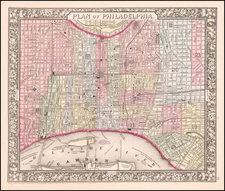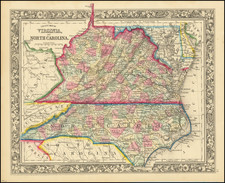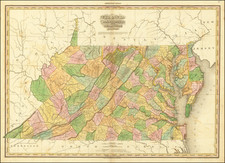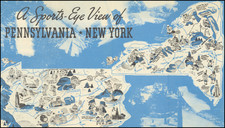The US Forges A Road To The Old Northwest Territory
Detailed map of the National Road, extending from the Potomac River to the Ohio River, from John Melish's Description of the United States & Travellers Directory, first issued in 1822.
The map illustrates in detail this important American transit route, including mileage between towns, river crossings,etc. The key identifies Churches, Mills and Furnaces & Forges along the route.
The National Road west (originally known as the Cumberland Road) was proposed by Act of Congress in 1806 and later signed by President thomas Jefferson, who also appointed the first commissioners. The intent of the National Road was to establish a reliable route to the soon to be established states in the old Northwest Territory (Ohio, Indiana, Illinois, Michigan).
Construction began on the section west from Cumberland in 1811. By 1818, the first transit was opened between Washington and Wheeling. The Panic of 1819 stopped work on the Naitonal Road until1822, when a bill for repair of the road and authority to collect tolls passed the Congress, but was vetoed by President James Monroe. Monroe held that Congress did not have the right of jurisdiction and construction. Monroe did however advocate a national system of internal improvements.
A number of alternatives were examined for additional 'National Roads', including a route up the Susquehanna River valley. However only the Old National Road, today's US 40, was constructed by the Federal government during the 19th century. It was continued west across Ohio in the late 1820's eventually reaching Vandalia, then the capital of Illinois.
John Melish (1771-1822) was the most prominent American mapmaker of his generation, even though his cartographic career lasted only a decade. Melish was born in Scotland; he moved to the West Indies in 1798 and then to the United States in 1806. By 1811, he had settled in Philadelphia and published Travels through the United States of America, in the years 1806 & 1807, and 1809, 1810, & 1811, which was richly illustrated with maps.
Melish created several regional maps of the highest quality, as well as the Military & Topographical Atlas of the United States (Philadelphia, 1813, expanded 1815). The latter work is widely considered to be the finest cartographic publication to come out of the War of 1812.
By far his best-known work is his monumental map of the United States of 1816, Map of the United States with the contiguous British and Spanish Possessions. He began working on the map in 1815 and sent it to Thomas Jefferson for comment in 1816. Jefferson enthusiastically reviewed the map and returned it with his edits. Jefferson later hung an example of the map in the Entrance Hall of Monticello and sent it to associates in Europe.
Melish’s finished product was the first map of the United States to extend to the Pacific Ocean. After its publication in 1816, Melish ensured the map was as up-to-date as possible; it was reissued in 25 known states published between 1816 and 1823. The map captured the then rapidly changing geography of the United States, as well as various boundary disputes, treaties, and expansion.












![(Map Seller's Canvassing Book) Subscribers to the Map of Greene County by Simon J. Martenet, Surveyor & Civ. Eng., Baltimore, Md, 1858 [Manuscript subscription book for Martenet map of Greene Co., Pennsylvania]](https://storage.googleapis.com/raremaps/img/small/77428.jpg)
![[ Carolinas & Georgia ] Virginiae Partis australis, et Floridae partis orientalis, interjacentiumqus regionum Nova Descriptio](https://storage.googleapis.com/raremaps/img/small/81554.jpg)
